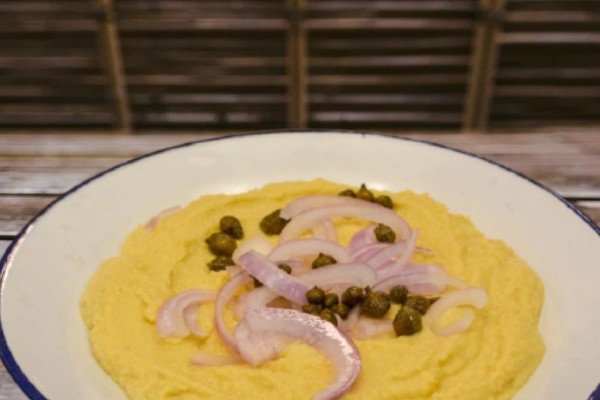Indulge in the authentic allure of Greek fava dip (φάβα in Greek), a cherished traditional dish crafted from vibrant yellow split peas. This velvety puree, seasoned with luscious olive oil, zesty lemon juice, and aromatic herbs like oregano, thyme, and bay leaves, takes center stage as a meze (appetizer) in Greek culinary traditions. Adorned with caramelized onions and adorned with capers or fresh herbs, fava dip boasts a distinct identity.
Unlike the familiar green peas, the Greek "fava" solely refers to yellow split peas. Delighting palates with a mild, slightly sweet flavor and creamy texture upon cooking, yellow split peas form the ideal base for purees and soups. Often dubbed "yellow split pea puree" or "Greek yellow split pea dip" in English-speaking circles, this delicacy echoes a harmony of tradition and innovation.
Akin to hummus, fava dip celebrates legume-based indulgence. However, distinctions emerge. Fava's essence lies in yellow split peas, while hummus finds its soul in chickpeas. A velvety texture defines fava, thanks to its tender yellow split peas' subtle sweetness. Olive oil, lemon juice, and herbs infuse fava's character, while hummus embraces tahini, garlic, and lemon.
Fava emerges as a wholesome powerhouse. Rich in protein, fiber, and essential nutrients, it ignites the senses while nourishing the body. With 26 grams of fiber per 100 grams, it champions digestion and satiety. This healthful choice beckons vegans and gluten-free seekers, offering a symphony of flavor and well-being.
As a snack, side dish, or main course, fava delights at every turn. Served warm or at room temperature, crowned with olive oil, and garnished with red onion and parsley, it captivates hearts across Santorini. Pair it with marinated sardines, octopus salad, smoked mackerel, or marinated anchovies, or revel in its simplicity with toasted bread or Greek pita.
Hailing from Santorini's fertile soil, this recipe captures the island's essence. Yellow split peas flourish their distinct taste and aroma a testament to Santorini's unique terroir. Ancient remains reveal the legacy of fava beans, alongside grapes, in archaeological realms.
To create fava dip, gather yellow split peas, red onion, garlic, olive oil, fresh thyme, bay leaf, parsley, salt, and pepper. This recipe, serving four, demands 70 minutes of preparation and 60 minutes of cooking—a feast for vegans and enthusiasts of authentic flavors alike.
Immerse yourself in the culinary legacy of Greece with this splendid fava dip, a true embodiment of tradition, nourishment, and artistry.
Greek Fava Recipe- Ingredients
- 225 g of yellow split peas
- 1 large red onion, chopped
- 2 cloves garlic, chopped
- 40 ml of Greek olive oil
- 2 sprigs of fresh thyme
- 1 bay leaf
- Salt and freshly ground pepper
- Olive oil to drizzle
- Red onion
- Fresh parsley, chopped
Greek Fava Recipe- How to Make
- Before starting this authentic Greek fava recipe, I suggest you rinse the split peas to remove any residue and set them aside.
- Take a saucepan and heat 2 tbsp of Greek olive oil. Fry the chopped onions until they become soft and translucent. Add the garlic and thyme and cook for another minute.
- Take another pan and put the split peas, bay leaf, salt, and pepper then add around one liter of water and bring to a boil.
- Cover the pan with a lid. Simmer for 50-60 minutes, until the water is absorbed and the peas have almost disintegrated.
- Remove the bay leaf and transfer the mixture to a food processor.
- Mix until the peas become smooth and creamy with the consistency of a puree.
- Add a little olive oil, salt, and pepper. Taste to see if additional seasoning is required.
- Serve warm on a large plate, garnished with red onion slices, a drizzle of olive oil, and chopped parsley.
